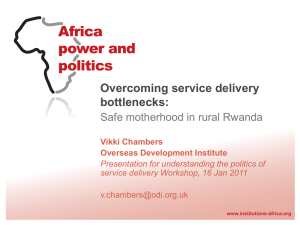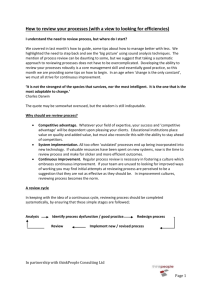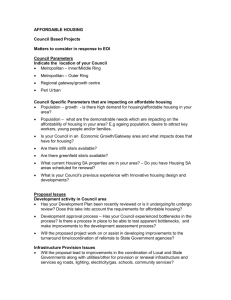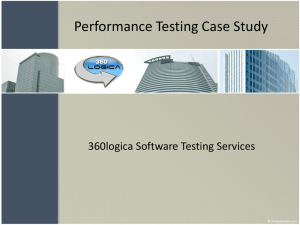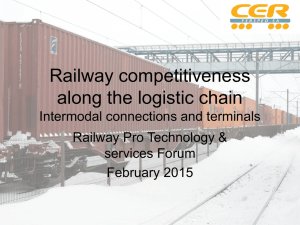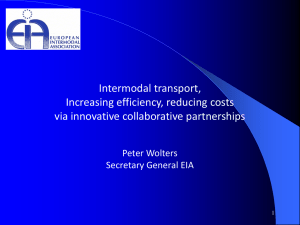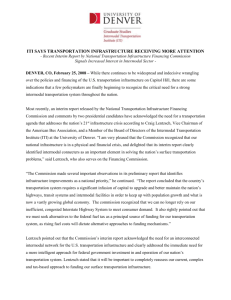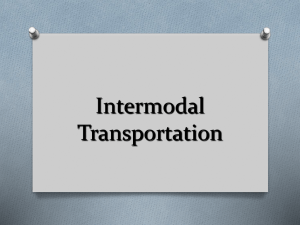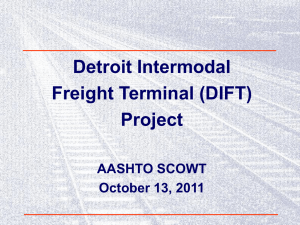INTERMODA paper for Transport Forum
advertisement
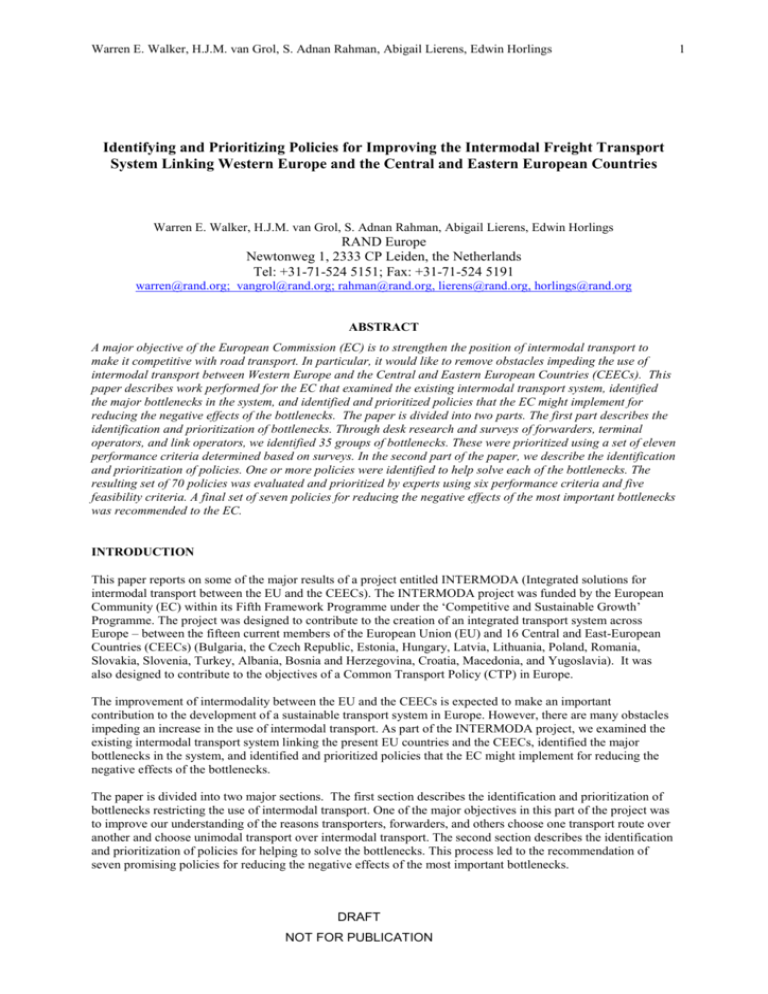
Warren E. Walker, H.J.M. van Grol, S. Adnan Rahman, Abigail Lierens, Edwin Horlings Identifying and Prioritizing Policies for Improving the Intermodal Freight Transport System Linking Western Europe and the Central and Eastern European Countries Warren E. Walker, H.J.M. van Grol, S. Adnan Rahman, Abigail Lierens, Edwin Horlings RAND Europe Newtonweg 1, 2333 CP Leiden, the Netherlands Tel: +31-71-524 5151; Fax: +31-71-524 5191 warren@rand.org; vangrol@rand.org; rahman@rand.org, lierens@rand.org, horlings@rand.org ABSTRACT A major objective of the European Commission (EC) is to strengthen the position of intermodal transport to make it competitive with road transport. In particular, it would like to remove obstacles impeding the use of intermodal transport between Western Europe and the Central and Eastern European Countries (CEECs). This paper describes work performed for the EC that examined the existing intermodal transport system, identified the major bottlenecks in the system, and identified and prioritized policies that the EC might implement for reducing the negative effects of the bottlenecks. The paper is divided into two parts. The first part describes the identification and prioritization of bottlenecks. Through desk research and surveys of forwarders, terminal operators, and link operators, we identified 35 groups of bottlenecks. These were prioritized using a set of eleven performance criteria determined based on surveys. In the second part of the paper, we describe the identification and prioritization of policies. One or more policies were identified to help solve each of the bottlenecks. The resulting set of 70 policies was evaluated and prioritized by experts using six performance criteria and five feasibility criteria. A final set of seven policies for reducing the negative effects of the most important bottlenecks was recommended to the EC. INTRODUCTION This paper reports on some of the major results of a project entitled INTERMODA (Integrated solutions for intermodal transport between the EU and the CEECs). The INTERMODA project was funded by the European Community (EC) within its Fifth Framework Programme under the ‘Competitive and Sustainable Growth’ Programme. The project was designed to contribute to the creation of an integrated transport system across Europe – between the fifteen current members of the European Union (EU) and 16 Central and East-European Countries (CEECs) (Bulgaria, the Czech Republic, Estonia, Hungary, Latvia, Lithuania, Poland, Romania, Slovakia, Slovenia, Turkey, Albania, Bosnia and Herzegovina, Croatia, Macedonia, and Yugoslavia). It was also designed to contribute to the objectives of a Common Transport Policy (CTP) in Europe. The improvement of intermodality between the EU and the CEECs is expected to make an important contribution to the development of a sustainable transport system in Europe. However, there are many obstacles impeding an increase in the use of intermodal transport. As part of the INTERMODA project, we examined the existing intermodal transport system linking the present EU countries and the CEECs, identified the major bottlenecks in the system, and identified and prioritized policies that the EC might implement for reducing the negative effects of the bottlenecks. The paper is divided into two major sections. The first section describes the identification and prioritization of bottlenecks restricting the use of intermodal transport. One of the major objectives in this part of the project was to improve our understanding of the reasons transporters, forwarders, and others choose one transport route over another and choose unimodal transport over intermodal transport. The second section describes the identification and prioritization of policies for helping to solve the bottlenecks. This process led to the recommendation of seven promising policies for reducing the negative effects of the most important bottlenecks. DRAFT NOT FOR PUBLICATION 1 Warren E. Walker, H.J.M. van Grol, S. Adnan Rahman, Abigail Lierens, Edwin Horlings IDENTIFYING AND PRIORITISING BOTTLENECKS IN THE INTERMODAL TRANSPORT SYSTEM Defining the Intermodal Transport System and Bottlenecks The intermodal transport system consists of the entire flow of goods on the entire transport infrastructure network, over all modes and transport vehicles, together with all related services (such as transhipment, storage, etc.) and service providers. The intermodal transport network consists of nodes and links. A node is a terminal where goods are loaded onto a mode or transhipped from one mode to another. A link is a connection between two terminals along which the mode of transport cannot change. Bottlenecks can also occur at national borders, which can be considered virtual nodes. An intermodal bottleneck is an actual or perceived negative characteristic of an intermodal door-to-door transport chain that makes intermodal transport less attractive than unimodal transport. Although some bottlenecks will equally affect all types of transport (unimodal, multi-modal, intermodal, combined transport), we were interested only in those that have an impact on the choice for intermodality. Bottlenecks can appear individually (an otherwise efficient system disrupted by a single problem) or through an accumulation of inefficiencies (e.g. narrow and ill-maintained roads, outdated equipment, inefficient handlers at terminals, resulting in long delays). Bottlenecks can be located at pressure points on the intermodal transport network; that is, they can occur in individual elements, such as: at the origin; during transport (i.e., on the links); at points of transshipment (i.e., at terminals); at virtual nodes, such as borders; at the destination. The entire route (or large parts of it) from origin to destination could be a bottleneck. Bottlenecks can also be systemic (e.g. legal inefficiencies that affect all intermodal transport in an entire region or country). This means that, in more general terms, bottlenecks can occur in: finding the intermodal solution (this is an information problem: do transporters know about their alternatives?); transporting goods between nodes; loading, unloading and transhipment; the general context of transport in a region or country. Bottlenecks can be distinguished according to different criteria. In INTERMODA we used a categorization based on the level of detail of the analysis that distinguishes among three types of bottlenecks: specific bottlenecks, which occur at only one location and can be solved through national policy. (For example, Riga suffers from a lack of ring roads and a city layout that makes through transport difficult). common bottlenecks, which occur at multiple locations but are specific to their location. No general action can be undertaken to eliminate common bottlenecks at all locations. (For example, many terminals have poor road access.) generic bottlenecks, which are inherent to the system. They occur at multiple locations but are identical in nature at all locations. A generic bottleneck is of the same nature everywhere and could be solved by a general policy. (For example, the railways systems in different countries have different gauge widths.) Our methodology for identifying bottlenecks in the intermodal transport system consisted of four steps: Step 1. Identify the major freight corridors between the CEECs and Western Europe and their associated freight flows Step 2. Identify the major transport routes within each corridor Step 3. Identify the major bottlenecks on each of the intermodal routes Step 4. Prioritize the intermodal bottlenecks These steps are described in the following four subsections. DRAFT NOT FOR PUBLICATION 2 Warren E. Walker, H.J.M. van Grol, S. Adnan Rahman, Abigail Lierens, Edwin Horlings 3 Step 1: Identify the Major Freight Corridors A corridor is a geographically defined “channel” through which a significant volume and concentration of transport flows pass. In order to determine the major transport corridors between Western Europe and the CEECs, we investigated the sizes and directions of the major transport flows, represented in the form of flows in tonnes between origin regions (O) and destination regions (D), using an O/D matrix of flows for the year 2000 that was created as part of the project. This analysis resulted in the identification of four major freight corridors. The first flow (corridor A in Figure 1) is the Northern European flow, going from North-West Europe (seaports, such as Hamburg and Bremen) and Scandinavia to the Baltic States and then on to Belarus and Russia. The second flow (corridor B in Figure 1) is the flow from North Western Europe to Poland on to Belarus and Russia. The third flow (corridor C in Figure 1) represents flow from North Western Europe to South Eastern Europe. The fourth flow (corridor D in Figure 1) goes from Southern Europe to South Eastern Europe and from Southern Europe towards Scandinavia. A. B. C. D. A B C D Northwestern Europe and Scandinavia—Baltic—Russia Northwestern Europe—Germany—Poland—Belarus and Russia Western Europe—Germany and Austria—Central Europe—Balkan—Black Sea Italy— Poland —Balkan—Black Sea FIGURE 1 Major Freight Corridors, Based on the Largest Transport Flows DRAFT NOT FOR PUBLICATION Warren E. Walker, H.J.M. van Grol, S. Adnan Rahman, Abigail Lierens, Edwin Horlings Step 2. Identify The Major Transport Routes Within Each Corridor A route is a set of links and nodes within the transport system that is used to carry goods from a specific origin node to a specific destination node. Within each corridor we identified the most important routes. Our approach in this step consisted of three parts. First, we interviewed a number of freight forwarders in Western Europe and the CEECs and asked them to describe their major routes (each was asked to describe two routes: a unimodal route and an intermodal route). Second, the O/D matrix supplied additional routes. Third, we obtained routes by examining services offered by forwarders on the Internet. The final selection of routes was based on the amount of freight flow along the route and the geographic spread among the routes. This process resulted in 19 selected intermodal routes (three in Corridor A, three in Corridor B, nine in Corridor C, and four in Corridor D). Step 3. Identify The Major Bottlenecks On Each Of The Intermodal Routes In this step, each of the 19 selected intermodal routes was investigated in detail using information from the forwarder interviews, interviews with experts, and desk research. This resulted in the list of 15 common bottlenecks and 7 generic bottlenecks shown in Table 1. TABLE 1 Common and Generic Bottlenecks Number Description of Bottleneck COMMON BOTTLENECKS Poor railway connection between main line and terminal/port C1 Large distance between terminal and main infrastructure network C2 Large distance between terminal and marshalling yard C3 Non-electrified tracks at terminals C4 Poor road access to terminals C5 Longer handling time due to poor equipment C6 Long marshalling time due to short tracks and limited number of tracks C7 Shortage of (intermodal) terminals C8 Insufficient terminal capacity C9 Inefficient rail network layout C10 Insufficient rail capacity C11 Narrow sections on waterways C12 Limited capacity of locks at hydropower stations en-route. C13 Low bridges on waterways C14 Too complex and cumbersome data exchange C15 GENERIC BOTTLENECKS Fixed opening times for terminals G1 Different and inconsistent border crossing procedures G2 Remote location of customs offices G3 Different gauge width of railway system in different countries G4 Different voltages in different countries G5 Unequal market conditions for road and intermodal transport G6 Interoperability G7 Step 4. Prioritize The Intermodal Bottlenecks In this step we ranked the bottlenecks according to the urgency of their removal, where urgency is defined by the impact of removal on the development of intermodal versus road transport. The method that we used to determine the ranking of the bottlenecks consists of three components: 1. develop criteria for the prioritization of bottlenecks, 2. combine the conclusions with the input of experts, 3. determine a ranking of common and generic bottlenecks. We decided that the criteria for prioritization should cover the main determinants of modal choice and capture the areas that are most in need of improvement and that have the biggest potential for improvement. In particular, the most important bottlenecks: are related to the major determinants of the choice for intermodal rather than road transport DRAFT NOT FOR PUBLICATION 4 Warren E. Walker, H.J.M. van Grol, S. Adnan Rahman, Abigail Lierens, Edwin Horlings relate to aspects for which intermodal transport has a disadvantage over road transport or that lower its performance with respect to aspects for which it has an advantage over road transport that when removed have the largest potential impact on the (relative) growth of intermodal transport The interviews with forwarders contained a question on the advantages and disadvantages of intermodal transport relative to road transport (see Figure 2). The question involved a simple judgment, based on experience with and understanding of the industry. No ranking or quantitative assessment was required. As a result, the answers appear to be consistent in that both interviewers and interviewees seem to have interpreted the question in the same way and have provided answers of the same quality. Question on the Forwarder Questionnaire: “Please compare intermodality to road transport on several factors. For each factor, use the following symbols to rate intermodal transport’s advantages and disadvantages.” Compared to road transport, intermodal transport has a: ++ + O = strong advantage = slight advantage = neutral = slight disadvantage = strong disadvantage FIGURE 2 The Question for all Forwarders The forwarders were asked to assess the advantage or disadvantage of intermodal transport with respect to eleven aspects. Table 2 describes these aspects. TABLE 2 Aspects of Intermodal Transport Aspect 1 Costs 2 Travel time 3 Reliability 4 Flexibility 5 Tracing of freight 6 Use of infrastructure 7 Scale/volume 8 Service of terminals 9 Legislation 10 Safety 11 Security Description Is intermodal transport cheaper or more expensive? Does it take longer or is it quicker than road transport? Is intermodal transport more or less reliable? This question relates to the length and frequency of delays. The safety and security of transport are dealt with separately. Can intermodal transport quickly adjust to changes in demand and in customer requirements, and is it available whenever needed? Can the location and status of load units and cargo be checked easily? Is the quality and capacity of infrastructure (including terminals) sufficient for intermodal transport? Is intermodal transport better or less able to handle large volumes of goods than road transport? Do the services provided at terminals give intermodal transport (which uses these terminals) an advantage over road transport or do they make it more cumbersome? Does intermodal transport have legal advantages or are there legal bottlenecks that road transport can circumvent? Do load units and cargo incur more or less damage in intermodal transport than in road transport? Are goods better or less well protected in intermodal transport? By rating the aspects, the forwarders provided us with information that allowed us to assess the importance of each aspect to the performance of intermodal transport relative to road transport. The 25 sets of answers from the interviews with the forwarders were analyzed to create frequency tables and to calculate descriptive statistics. Figure 3 summarizes the results of this analysis. The information in the figure suggests that the primary strengths DRAFT NOT FOR PUBLICATION 5 Warren E. Walker, H.J.M. van Grol, S. Adnan Rahman, Abigail Lierens, Edwin Horlings of intermodal transport are costs, scale or volume, safety and security, while its weaknesses are travel time and flexibility. In addition, the results suggest that intermodal transport has an advantage in tracking and tracing of freight and a disadvantage in its legal requirements. The crucial question is how to link the ranking of advantages and disadvantages to the list of common and generic bottlenecks. Linking these will enable us to prioritize bottlenecks. Each bottleneck affects one or more of the aspects that determine the choice for or against intermodal transport. Three types of effects can be distinguished: Direct effects The bottleneck translates directly into lower performance with respect to one of the determinants of mode choice. For example, poor equipment leads to longer handling times, which translates directly into longer travel times. Indirect derived effects The bottleneck has a direct effect on one aspect and, by changing the performance relative to that particular aspect, it also affects other aspects. For example, longer handling times directly translate into longer travel times, and by extending the travel time they indirectly raise the level of costs. Indirect implied effects the bottleneck does not directly affect an aspect but it most likely will influence the performance of intermodal transport with respect to that aspect. For example, poor transshipment equipment increases the possibility of damage to containers and goods (safety) and may reduce the volume of individual consignments that can be transshipped. Assuming that, within a group, improving the aspect in which intermodal transport has an advantage (e.g. cost) is to be preferred to improving an aspect in which intermodal transport has a disadvantage (e.g. travel time), and only considering direct effects, produces the ranking of bottlenecks (from higher to lower importance) shown in Table 3. TABLE 3 A Tentative Ranking of Common (C) and Generic (G) Bottlenecks Ranking highest lowest Number G6 G1 C11 G7 C10 C13 C7 C9 C2 C3 C1 C5 C12 C6 C14 C8 C15 C4 G4 G5 G3 G2 Description of Bottneleck Unequal market conditions for road and intermodal transport Limited opening times of terminals Insufficient rail capacity Interoperability in general Inefficient rail network layout Limited capacity of locks at hydropower stations en-route Long marshalling time due to short tracks and limited number of tracks Insufficient terminal capacity Large distance between terminal and main infrastructure network Large distance between terminal and marshalling yard Poor railway connection between main line and terminal/port Poor road access to terminals Narrow sections on waterways Longer handling time due to poor equipment Low bridges on waterways Shortage of (intermodal) terminals Too complex and cumbersome data exchange No electrified tracks at terminals Different gauge width of railway system in different countries Different voltages in different countries Remote location of customs offices Different and inconsistent border crossing procedures We convened a workshop with experts on intermodal transport to discuss the common and generic bottlenecks we had identified, to add ones that they thought were missing, and to assign priorities. This exercise plus subsequent analysis led to a final list of 23 common bottlenecks and 12 generic bottlenecks (in total, 35 bottlenecks), which were divided into four groups: DRAFT NOT FOR PUBLICATION 6 Warren E. Walker, H.J.M. van Grol, S. Adnan Rahman, Abigail Lierens, Edwin Horlings Terminals Capacity of links Interoperability Market conditions Each group contains bottlenecks of a comparable or homogeneous type that can be addressed using similar policies. In fact, it is possible that a single policy will have effects on some or all of the bottlenecks in a group. At the workshop, each of the 35 bottlenecks was assigned an importance classification (high, medium, and low) by the experts, by RAND Europe, and by the other members of the consortium. These ratings were then combined, to produce an overall rating (high, medium, or low) for each of the bottlenecks. This process resulted in the categorization and prioritization shown in Table 4. It must be noted that within their level of rating (high, medium, low) the bottlenecks are not ranked; they are bundled into the four abovementioned groups. DRAFT NOT FOR PUBLICATION 7 Warren E. Walker, H.J.M. van Grol, S. Adnan Rahman, Abigail Lierens, Edwin Horlings 8 TABLE 4 Final Categorization and Prioritization of Bottlenecks Priority Group Terminal – access Terminal – capacity Terminal – operations Capacity of links – general Capacity of links – rail Capacity of links – inland waterways HIGH Interoperability – border crossing Interoperability – technical Market conditions – inadequate market information Market conditions – unfavorable cost structure Market conditions – legislation Terminal – access Terminal – operations Capacity of links – rail MEDIUM Interoperability – border crossing Interoperability – technical Market conditions – inadequate market information Market conditions – legislation Bottleneck G1 Limited opening times of terminals C8 Shortage of (intermodal) terminals C9 Insufficient terminal capacity C23 Lack of appropriate combined-transport equipment C7 Long marshalling time due to short tracks and a limited number of tracks C17 Inadequate width and height of tunnels C11 Insufficient railroad capacity C18 Shallow sections on waterways G2 Different and inconsistent border crossing procedures G10 Countries have different weight limits G12 Lack of interoperability across national networks G7 Interoperability in general G8 Lack of sufficient demand for intermodal services G6 Unequal market conditions for road and intermodal transport G9 Lack of return freight, and cabotage C16 An inadequate legislative framework C5 Poor road access to terminals C6 Longer handling time due to poor equipment C10 Inefficient layout of the railroad network G4 Different gauge width of railway systems in different countries G5 Different voltages in different countries G11 Operational differences (signaling) C20 Tariff setting takes too long Terminal – access Terminal – operations Capacity of links – general LOW Capacity of links – inland waterways Interoperability – border crossing Market conditions – inadequate market information C22 Not all terminals can handle dangerous goods C2 Large distance between the terminal and the main infrastructure network C4 No electrified tracks at terminals G3 Remote location of customs offices C21 Lack of qualified personnel (especially locomotive drivers) C12 Narrow sections on waterways C13 Limited capacity of locks at hydropower stations enroute C14 Low bridges on waterways C19 Spatial planning does not include the industrial parts of the inland waterways C21 Lack of qualified personnel (differences in qualifications and requirements) C15 Too complex and cumbersome data exchange DRAFT NOT FOR PUBLICATION Warren E. Walker, H.J.M. van Grol, S. Adnan Rahman, Abigail Lierens, Edwin Horlings 9 IDENTIFYING AND PRIORITISING POLICIES FOR REDUCING BOTTLENECKS IN THE INTERMODAL TRANSPORT SYSTEM Description of the Method Used Figure 4 provides an overview of the steps in the policy assessment. The four steps shown in the figure are aggregations over the six steps (A-F) that are explained in detail below. The aggregate steps (and their correspondence with the detailed steps) are: 1. 2. 3. 4. Identify and prioritize the bottlenecks (Step A) Identify policy measures for the bottlenecks (Step B) Evaluate policy measures on performance and feasibility (Step C-E) Rank the policy measures and identify the most promising (Step F) Step 1 35Identify bottlenecks and prioritize bottlenecks Step 2 35 bottlenecks Identify policy measures for bottlenecks Step 3 35 bottlenecks Evaluate policy measures on performance and feasibility Step 4 35 bottlenecks Rank policy measures 35 bottlenecks 70 policy measures 19 ‘high performance’ and 20 ‘good feasibility’measures 7 most promising policy measures FIGURE 4 Method for Identifying Promising Policy Measures Identify and Prioritize the Bottlenecks (Step A) The previous section described how we identified and prioritized 23 common bottlenecks and 12 generic bottlenecks. These 35 bottlenecks, which are listed in Table 4, form the basis for the policy assessment described in this section. Identify Policy Measures for the Bottlenecks (Step B) For each bottleneck, we identified one or more policy measures that might help solve it. These policies came from the existing literature and from brainstorming within the project team. This process resulted in a list of 70 policy measures (there are one or more measures for each bottleneck, and some measures apply to several bottlenecks). Evaluate Policy Measures on Performance and Feasibility (Step C) The policy measures were assessed in two steps: 1. The partners evaluated each of the 70 policies on each of six aspects of performance and five aspects of feasibility. 2. Nine experts examined the partners’ evaluations and suggested changes. The six aspects of performance assessment are: 1. Travel time: What would be the effect on travel time? 2. Costs: What would be the effect on the transport costs? 3. Flexibility: What would be the effect on flexibility? 4. Reliability: What would be the effect on reliability (length and frequency of delays) 5. Safety: What would be the effects on safety? 6. Security: What would be the effects on security? Are goods better or less well protected? These aspects are a subset of the aspects that were used to assess the bottlenecks. The six selected aspects are aspects that are end objectives. Other aspects from the bottleneck assessment were not used because they are means objectives, rather than end objectives. For example, legislation is a means for achieving successful intermodal transport, but creating or changing legislation is not an end in itself. DRAFT NOT FOR PUBLICATION Warren E. Walker, H.J.M. van Grol, S. Adnan Rahman, Abigail Lierens, Edwin Horlings 10 The partners were asked to indicate if they thought a policy measure would have a strong positive (+2), a positive (+1), a negative (-1) a strong negative (-2) or a neutral (0) effect on the bottleneck. They could also add one or two additional bottlenecks that the policy might affect. The five aspects of feasibility assessment related to the implementation of a policy measure are: 1. Financial consequences: The degree to which the implementation of the policy can be financed and managed. This indicator is related to the amount of resources estimated to be required for construction and operation 2. Technological possibilities: Whether it is possible by 2020 to adopt the necessary new technologies or whether the new technologies are compatible with the existing infrastructure 3. Political climate: The level of political support for the measure (e.g., does the measure go against current policy?) 4. Public acceptance: The degree to which the public (including firms, pressure groups and other institutional organizations) are likely to accept the policy 5. Institutional complexity: Does the policy fit into current legal and institutional structures or are major problems foreseen that may hinder implementation? The partners could indicate per aspect if the implementation of the policy measure would be very easily feasible (+2), slightly feasible (+1), feasible, not easily, but also not with great difficulty (0), slightly infeasible (-1) or infeasible (-2). For each policy and each of the 11 aspects, the results from the first step (among partners) were averaged and the standard deviation was calculated. The standard deviation was used to identify disagreements, which were then addressed and resolved. (Step D) Nine experts were then asked to judge the assessed policies from Step C. If they disagreed with the scores, they could revise them. Space was provided for them to explain their revisions. As in the first step, the score for a policy measure on each of the six performance aspects and on each of the five feasibility aspects could range from a strong positive (2) through neutral (0) to a strong negative. To get more detail into the scoring, they were allowed to use increments of 0.5 (this was a change from the scoring used in the first step). (Step E) The results from the policy assessment (Step D) were then analyzed. The final score for each policy was produced by taking weighted averages. The bottlenecks, performance aspects, and feasibility aspects were all assigned weights. In the bottleneck analysis described in the previous section, each bottleneck had been assigned to one of three categories: high priority, medium priority, or low priority. In the policy analysis, highpriority bottlenecks were assigned a weight of 3, medium-priority bottlenecks were assigned a weight of 2, and low-priority bottlenecks were assigned a weight of 1. In weighing the performance aspects, the aspects travel time and costs were recognized as most important and received a weight of 2, while all other aspects received a weight of 1. For feasibility, all aspects received a weight of 1. In order to give higher priority to policies affecting multiple bottlenecks, final performance scores were produced for each policy by dividing the policy’s total performance score by the number of bottlenecks to which the policy related. Summarizing the above procedure, the scores for a policy are obtained in three stages. Using the following symbols, the procedure is: Xkj = the average (weighted) score for policy k on bottleneck j over all six of the performance aspects Yk = the average (weighted) score for policy k over all five of the feasibility aspects Zk = the final score for policy k Pikj = policy k’s score on performance aspect i (i = 1, 2, . . . , 6) for bottleneck j pi = the weight assigned to performance aspect i (i = 1, 2, . . . , 6) Fmk = policy k’s score on feasibility aspect m (m = 1, 2, . . . , 5) fm = the weight assigned to feasibility aspect m (m = 1, 2, . . . , 5) bj = the weight assigned to bottleneck j nk = the number of bottlenecks associated with policy k Stage 1: Calculate the performance score of policy k for bottleneck j DRAFT NOT FOR PUBLICATION Warren E. Walker, H.J.M. van Grol, S. Adnan Rahman, Abigail Lierens, Edwin Horlings 11 6 X kj pi Pikj i 1 Stage 2: Calculate the feasibility score for policy k 5 Yk f m 1 m Fmk 5 f m 1 m Stage 3: Calculate the final performance score for policy k nk Zk b j 1 j X kj nk Evaluate Policy Measures on Performance and Feasibility (Step F) The policy measures were ranked in descending order based on the final performance scores calculated in Step E. The ranked list of policy measures was divided into three groups: high impact policies (scores above 2), medium impact policies (scores between 1 and 2), and low impact policies (scores below 1). The feasibility scores were used to assign the policies to three feasibility categories: good (scores above 0.5), neutral (scores between 0 and 0.5), and poor (scores below 0). Prioritizing the Policies The first step in our analysis of the results was to perform a simple ranking of policies according to their performance scores. Tables 5, 6, and 7 present this ranking according to the three performance categories (high medium, and low) and associate each policy with its feasibility category (poor, neutral, or good). In order to focus our attention toward the most important policies, we combined the ranking of policies with the ranking of bottlenecks. This allowed us to identify policies that have a high impact on highly important bottlenecks. Such policies are more likely to improve not only individual bottlenecks, but also the development of the European intermodal transport system as a whole. Table 8 shows the relationships between bottlenecks and policies. The aim of the policies recommended by INTERMODA was to achieve the largest possible effect on intermodal transport by efficiently concentrating scarce resources. We therefore focused the policies primarily on addressing the problems of high and medium importance bottlenecks. The most effective methods of eliminating such bottlenecks are provided by the high and medium performance policies. We have consequently not included the low-importance bottlenecks and the low-impact policies in Table 8. Of the initial 70 policies, 19 are high-impact policies, 30 are medium-impact policies and 21 are low-impact policies; 12 policies have poor feasibility, 48 have neutral feasibility and 12 have good feasibility. Of the 19 high-impact policies, 2 have poor feasibility, 10 have neutral feasibility and 7 have good feasibility. The 7 highimpact policies with good feasibility affect half of the high-importance bottlenecks. The 19 high-impact policies are primarily targeted at changing and standardizing legislation or at creating financial possibilities for the development of intermodal transport. The creation of financial possibilities for the building of new infrastructure is considered to be much less feasible than the upgrading of existing infrastructure (which has either a neutral or a good feasibility). The high-impact policies are also generally targeted at improving operations by better utilizing or upgrading infrastructure and equipment. Policies that target bottlenecks that do not concern either infrastructure or equipment —e.g. policies to train personnel or to improve the environment— are expected to have low impact. The experts also concluded that a marketing campaign aimed at encouraging the use of intermodal transport and support for the increased use of ICT are expected to have little impact. DRAFT NOT FOR PUBLICATION Warren E. Walker, H.J.M. van Grol, S. Adnan Rahman, Abigail Lierens, Edwin Horlings 12 TABLE 5 High-Performance Policies Feasibility Performance Policy Poor HIGH 32 Set standards for administrative and technical customs procedures 40 Set standards for load units 10 Set standards for combined-transport equipment 7 Introduce fund for building new terminals 29 Set safety standards 6 Change Terminal Opening Time Regulations 18 Introduce fund for restructuring railroad networks 9 Introduce fund for replacing of obsolete handling equipment 19 Introduce fund for building new railroads 11 Introduce fund for restructuring terminals 20 Introduce all-cargo lines 15 Introduce fund for building new tunnels 12 Introduce fund for restructuring terminals operations 30 Check safety at departure and arrival 26 Introduce fund for dredging waterways 39 Set up a European traffic control center (e.g. EUROCONTROL) for railway transport 61 Introduce fund for lengthening tracks at terminals to standard train length (700m) 33 Adapt legislation to allow foreign trains and train drivers on the national network 14 Introduce fund for enhancing the capacity of existing tunnels Determine alternative routes to avoid low-capacity tunnels and 16 encourage their use DRAFT NOT FOR PUBLICATION Neutral Good X X X X X X X X X X X X X X X X X X X X Warren E. Walker, H.J.M. van Grol, S. Adnan Rahman, Abigail Lierens, Edwin Horlings 13 TABLE 6 Medium-Performance Policies Performance Policy MEDIUM Poor 42 Develop European standard for data exchange between operators, terminals, customs etc. 31 Harmonize gauge and voltage differences 23 Introduce fund for widening narrow sections of waterways 21 Give priority to freight on the rail network 8 Introduce fund for expanding existing terminals 54 Enforce Technical Standards Across Modes 43 Set standards for the documentation of freight 69 Set rules to harmonize working times 67 Increase the legal speed limits for trains 52 Set up program to improve market information 64 Introduce fund for improving transshipment facilities at stations where different gauges meet 57 Enable private funding (public-private partnership) for intermodal terminals 63 Set standards for signaling equipment 34 Introduce Fund for using flexible wheel-based carriages 1 Introduce fund for relocation of terminals 49 Set rules to harmonize the enforcement of labor regulations 47 Introduce fund for introducing and performing logistics scans 41 36 53 62 5 35 65 4 60 68 17 3 58 Set standards for signaling operations Set standards for weight limits Set standards for assessing liability in different modes Introduce fund for the usage of more flexible transporter wagons Include terminals in TEN Introduce fund for replacing common locomotives by multivoltage locomotives Stimulate the use of ICT Introduce fund for constructing of infrastructure between terminals and the main network Introduce fund for the usage of special low floor transport wagons Set English as official language for train operations Include railroad network in TEN Introduce fund for improving infrastructure between terminals and the main network Introduce fund for building extra storage facilities at terminals DRAFT NOT FOR PUBLICATION Feasibility Neutral Good X X X X X X X X X X X X X X X X X X X X X X X X X X X X X X Warren E. Walker, H.J.M. van Grol, S. Adnan Rahman, Abigail Lierens, Edwin Horlings 14 TABLE 7 Low-Performance Policies Performance Policy 48 27 37 2 22 13 38 28 24 56 59 LOW 44 25 45 70 46 66 55 50 51 16 Set rules to harmonize infrastructure charges Subsidize the use of shallow-drawing ships Set standards for the carrying-capacity of new roads Introduce fund for concentration of terminals Introduce Double-Stack Trains Relocate Customs Offices to Terminals Set up a European training institute for rail personnel Stimulate the inclusion of development of inland waterway ports as logistic centers in existing and new zonal plans Introduce fund for increasing lock capacities Introduce fund for investing in special storage facilities and handling equipment for dangerous goods Change customs regulations to enable custom procedures to be carried out directly at the premises of the client Introduce fund for investments in ICT applications for tracking and tracing Introduce fund for raising low bridges on waterways Start marketing campaign for intermodal transport Set European qualification standards for personnel Introduce fund for investing in ICT applications for tariff setting Set higher standards on the number of wagons per train Adjust legislation to allow dangerous goods to stay in terminals without storage facilities for more than 24 hours Set standards for environmental impacts Set environmental charges Determine alternative routes to avoid low-capacity tunnels and encourage their use DRAFT NOT FOR PUBLICATION Poor X Feasibility Neutral Good X X X X X X X X X X X X X X X X X X X X Warren E. Walker, H.J.M. van Grol, S. Adnan Rahman, Abigail Lierens, Edwin Horlings 15 TABLE 8 Combined Ranking of Policies and Bottlenecks Policy Bottleneck 32 40 G1 High importance C8 C9 C23 C7 C17 C11 C18 G2 X G10 G12 X G7 G8 G6 G9 C16 Medium C5 importance C6 C10 G4 G5 G11 C20 C22 High Medium 10 7 29 6 18 9 19 11 20 15 12 30 26 39 61 33 14 42 31 23 21 8 54 43 69 67 52 64 57 63 34 1 49 47 41 36 53 62 5 35 65 4 60 68 17 3 58 X X X X X X X X X X X X X X X X X X X X X X X X X X X X X X X X X X X X X X X X X X X X X X X X X X X X X X X X X X X X X X X X X X X X X X X X X X X X X DRAFT NOT FOR PUBLICATION Warren E. Walker, H.J.M. van Grol, S. Adnan Rahman, Abigail Lierens, Edwin Horlings 16 The gray-colored box in Table 8 shows the combination of high-impact policies and high-importance bottlenecks. Of the 19 high-impact policies 7 have good feasibility. These are targeted at 8 out of the 16 high-importance bottlenecks. These 7 policies fall into three categories, and can be summarized as: 1. Modernization. Introduce mechanisms to facilitate: the replacement of obsolete handling equipment the improvement of terminals the improvement of terminal operations the restructuring of railroad networks 2. Standardization. Set standards for combined transport equipment Standardize and reduce safety checks at borders 3. Safety. Check safety at departure and arrival (and not at borders) These 7 policies are the best candidates for forming policy packages and are the ones that we recommended as the highest priority to the European Commission. ACKNOWLEDGMENT The INTERMODA project was carried out by a consortium in which RAND Europe was one of eleven partners. Further details about the project, including copies of the executive summaries of reports and results can be found on the project’s Website: www.intermoda.org. DRAFT NOT FOR PUBLICATION

